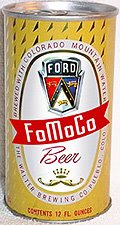 Of course, this is the 406 I wish we were talking about. That's a really nice period piece of early sixties' Blue Oval, "Total Performance" FE blocked coolness, but I will most inevitably end up with a strong armed iron mouse under my hood- since that was what it came to me with.
Of course, this is the 406 I wish we were talking about. That's a really nice period piece of early sixties' Blue Oval, "Total Performance" FE blocked coolness, but I will most inevitably end up with a strong armed iron mouse under my hood- since that was what it came to me with.After pulling down the 400 SBC that came in the '58, I (we) discovered that water had been standing in three of the 8 cylinders for some time. it was pretty much locked up. Good times.

......but that other than some rust pitting in the cylinders, the motor was original, and in excellent shape. The crank was particularly nice.
Parts
With a .030" overbore needed to cover my stupid mistake, new pistons became necessary.
There were only two reasonably priced sources for flat-top "street" pistons for the 400: Keith Black or Speed Pro. The units I ended up with are Speed pro Hyperuetectics, with a + 5cc valve reliefs, and a .022" deck clearance. That yields about a 9.7:1 static comp ratio with the 76cc chambers on my smog "882" heads.


Isky
Cam selection, is well, a trip. After reading through Super Chevy magazine's "Danger Mouse"series:
http://www.superchevy.com/tech/0312sc_355_cid_short_block/index.html
I started with the obvious choice, right?? The Comp Cams XE262 cam.
After playing endlessly, and learning alot ( I actually spoke with Ron Iskendarian on the phone); - the cam that yielded the best torque curve, and the highest HP numbers was NOT the cam with the biggest lift/duration numbers.
I ended up with a pretty modest Isky stick (216°/216° @ .050"- .450"/.450"), but on a 108° lobe separation angle.
 108° Lobe separation angles are, well, old school. That is, back from the days when leaded, high octane fuel was plentiful, and cars could run far higher cylinder pressures without pre-detonation. "So", you say? you already knew that?
108° Lobe separation angles are, well, old school. That is, back from the days when leaded, high octane fuel was plentiful, and cars could run far higher cylinder pressures without pre-detonation. "So", you say? you already knew that?Here's the thing: Most newer cams are ground on a wider lobe separation angle (like 112°-114°)- which allows vehicles like new Camaros/Corvettes/Mustangs to run longer duration cams/ higher theoretical compression ratios with a smooth idle, vacuum, and no pre-detonation. It also spreads the power curve out more evenly. It makes for somewhat of a boring street motor, though; lower torque numbers, and less throttle response due to lower cylinder pressures at low rpm's.

Fun facts- a narrow LSA will give you a crunchier idle, better cylinder pressure at low rpm's(more throttle response down low). The down side is that the powerband is theoretically smaller. The smaller an LSA gets, the closer the motor gets to being like a "oval track" car. Designed to make peak power in a narrow RPM range. Theoretically, that is..
Hidden power
Here's the thing: A narrow LSA can also help a motor with weak (as in "882") heads at higher RPM's. This occurs through higher velocity scavenging on the exhaust side (where it counts). I am not 100% on the theory behind this, but the Dyno program shows my little Isky cam as making the best peak HP @ 338 (beating the bigger cams by 27+ HP), but also-- while the Comp Cams XE262 and even the XE268 fell dramatically on their face by around 4800 RPM, the little 264 Mega cam shows as making 300 or more HP from 4,000 through 6,000 RPM- this is with the stock heads. It's also worth pointing out that while the larger duration XE Comp Cams got beat on peak HP, they also left TORQUE lieing on the table down low.
The 108 Isky cam ended up making the best torque (420 ft/lbs), and making at least 400 ft/lbs from around 1,500 RPM all the way through 4,000 rpm. That's some serious grunt.
That means that at oh, about 14 mph in 1st gear- I'll have 400 ft/lbs of torque on tap. Tire shred-o-matic.
I mean....if you're into that sort of thing.




1 comment:
I located a great deal of exciting information and facts here. The submit was professionally created and that I feel such as the writer has comprehensive know-how within the topic. Preserve it this way.
Well Optimization, Progressive CavityPump
Post a Comment